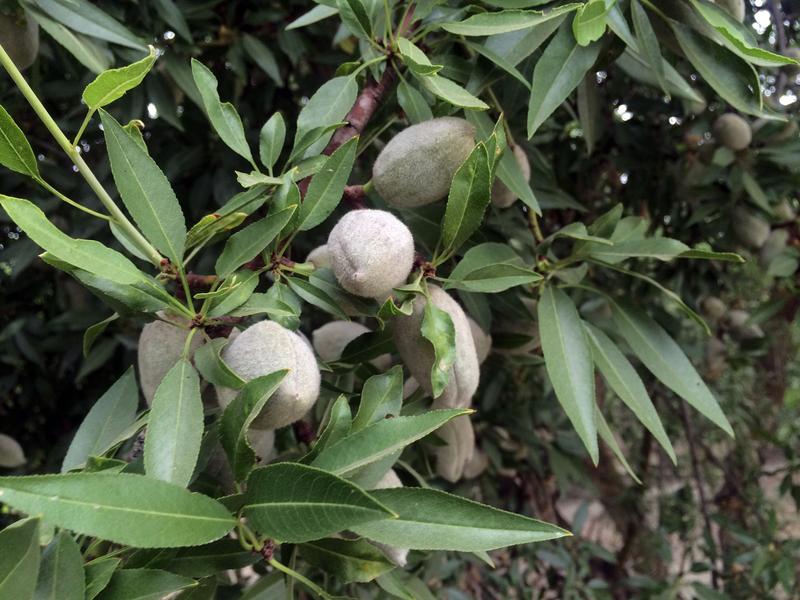The Price Of Almonds May Have Met A Slippery Slope

Drive anywhere in Central California and you'll find fields of almonds. So many new trees have been planted in recent years that people have begun to wonder whether the growth of the almond industry is unsustainable. It seems like the price of the nut may have met a slippery slope.
It started out with almonds getting a lot of bad press over the last few years. The nut was called out for soaking up too much water, while at the same time farmers were making bank on the tree crop. Meanwhile, the commodity slowly lost value.
Vernon Crowder says the price of the nut per pound has dropped "about 20 percent, maybe just a little bit more, since late 2014." Crowder is part of a Food and Agribusiness Research Advisory Group with Rabobank in Fresno.
That 20 percent equals a loss of around $1.8 billion. Crowder says the problem is too much supply.
"There have been a lot of new almonds planted over the last three years," says Crowder. "And that's probably part of the reason why the crop was a little bigger than we expected this year. And people know there will be more almonds produced this fall as well."
When the price of almonds rose from around $2.50 three years ago to over $4 per pound in 2014, farmers went crazy. Many replaced their lower-priced crops, like grapes or cotton, with fields of almonds. That flooded the market, and the price dropped to around $3 per pound.
The real kicker was the strength of the dollar in 2015. It began to cost more for places like China and India to buy almonds. In turn, Asian markets are shelling out less cash for the crop.
"We probably pushed the price up too high," says Darren Rigg. He handles over 50 million pounds of nuts with Meridian Growers in Tulare, Calif.
"It killed off demand, and people at a certain point, they just don't buy," Rigg says. "We're probably coming back into an equilibrium point, but we possibly have overcorrected as well."
He says over-reliance on markets with a lack of infrastructure and shaky finances are the root cause.
"The whole entire industry has dealt with a lot of defaults out of India and Dubai," says Rigg. "Guys going out of business, guys not picking up loads. And some of them just packing up shop and running off to the Himalayas. And so we still have cargo at foreign ports."
Even with the current decrease in the price per pound of almonds, growers are still earning more than they were five years ago. Almond growers like Joe Del Bosque in Firebaugh, Calif., say they haven't felt the pinch yet.
"Having a couple of good years has given us a good foundation ... to be able to weather this thing," Del Bosque says.
Del Bosque farms more than 600 acres of almonds. And he says he does worry that the high cost of water, coupled with the lower price of almonds, would decrease profits.
"We're not panicking," Del Bosque says. "If the market stays where it is right now, I think we'll still be OK — if we have water that isn't too expensive this coming year."
But this is all a balancing act, and Mother Nature has a role to play. Adequate chill hours – almond trees need to rest in winter under 45 degrees for up to 300 hours for normal growth – and ample rains brought by El Nino could mean a healthy crop. But too large of a yield could depress the price of almonds, leading to fewer dollars in farmers' pockets.
At the same time, growers are worried that strong storms in February could knock too many flowers off trees during bloom time. The loss of too many flowers could result in a smaller crop — which would make almonds too expensive for foreign bank accounts. Both scenarios could lead to an even greater price drop, but the growers I spoke with remain optimistic.
Ezra David Romero covers food and agriculture for Valley Public Radio in California. This story first appeared on the station's website.
9(MDEwODYxNTQyMDEzNjAxODk2Nzc2NzNmYQ001))